Turn lookers into bookers with this deep dive into your most pressing hotel copywriting questions.
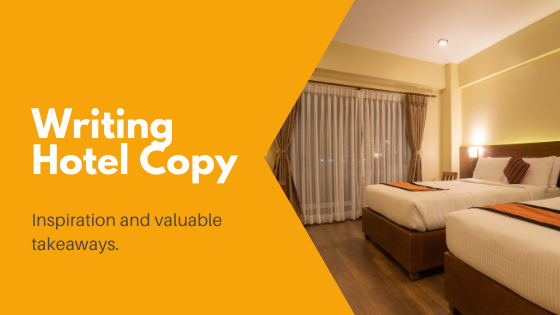
How to write effective web copy for hotel brands
Hotel marketers, are you searching for the best examples of hotel copywriting? The kind of text that grabs attention, captivates readers, and inspires action? What about the secrets behind successful conversion copywriting for hotels?
Good news: You’re in the right place!
In this post, we explore how to write for hospitality brands with the best hotel copywriting examples from around the world to illustrate key points. We also tackle the most frequently asked questions related to hotel copywriting. Questions like:
- How do I write web copy that makes my hotel stand out?
- What kind of copy will appeal to my ideal guest?
- What’s the best way to keep readers on my hotel website?
- How do I write an attractive hotel room description?
- What should I focus on to promote our F&B establishments?
- How do I properly address COVID-19 in my hotel copy?
First, a reminder: “Best” doesn’t always mean flawless. In fact, some of the examples you’ll see here even have spelling/grammatical errors! The “best”, in this case, is about what gets the job done. Because at the end of the day, that’s what matters—results.

So, how do you get results? Let’s find out!
The best examples of hotel copywriting
Strip away design, remove pretty photographs and you’ll notice that many hotels say pretty much the same thing. They even use the same words! Prime location? Check. Desirable amenities? Check. Boilerplate room descriptions? Check. As a result, hotel websites aren’t just redundant—they’re boring!
You don’t want that.
That’s why the hotel copywriting examples featured in this post are anything but “standard”. Instead, their writing is magnetic. Their copy makes you feel something, be it excitement, FOMO, or simply that you’re in good hands. Most importantly, what you read motivates you to do something about those feelings—like check availability, book a room, and even sign up for marketing emails.
In short, these are brilliant hotel marketing ideas executed with perfection. You’ll soon see why.
Q: How do I write web copy that makes my hotel stand out?
There are many strategies you can use to craft memorable copy; the kind that cuts through all the noise and wins readers’ hearts. These hotel copywriting examples are the perfect cases in point.
Villa Ivy (Austria)
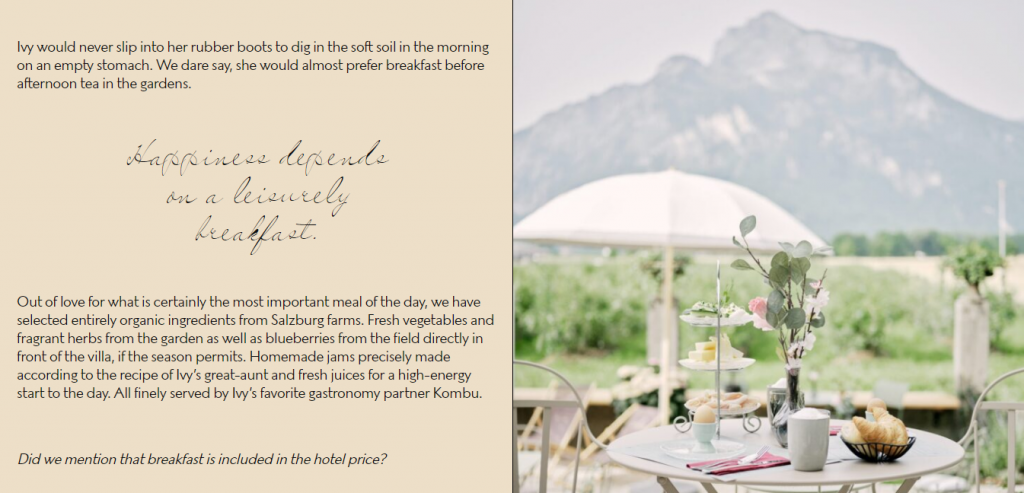
The first and perhaps most effective strategy is storytelling. Now storytelling may sound easy but it’s one of the hardest things to pull off well. Done wrong, it can come across as unprofessional. Like useless rambling. Done right, pages come alive—and draw you in. So, what you write stays fresh in the reader’s mind, building anticipation for a destination beautifully described.
That’s what Villa Ivy has managed to do with its web copy: There’s personality, there’s character, and there’s delight to be had in reading further.
Compared to typical hotel copy that merely enumerates what to expect, Villa Ivy’s makes it so that you can envision yourself there, taking it all in. Such visualization is great for brand recall and a clear win in landing more bookings.
COQ Hotel Paris (France)

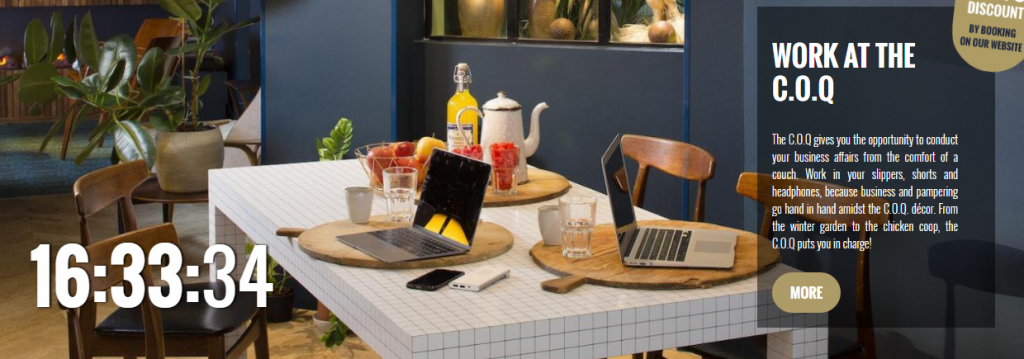
Another effective way to stand out is to capitalize on a theme, i.e. weave an interesting concept into your web copy and design.
Take a look at COQ Hotel Paris. The concept of “time” is ever-present: From menu buttons to copy centered around the powerful message of “time well spent” at their hotel. Put simply, their web copy isn’t just creative; it’s pure genius because from the get-go, it has you intrigued. What does the hotel have in store for me at 09h? What happens at 16h? The fact that it automatically piques your interest is a clear victory in terms of standing out.
Penh House and Jungle Addition (Cambodia)
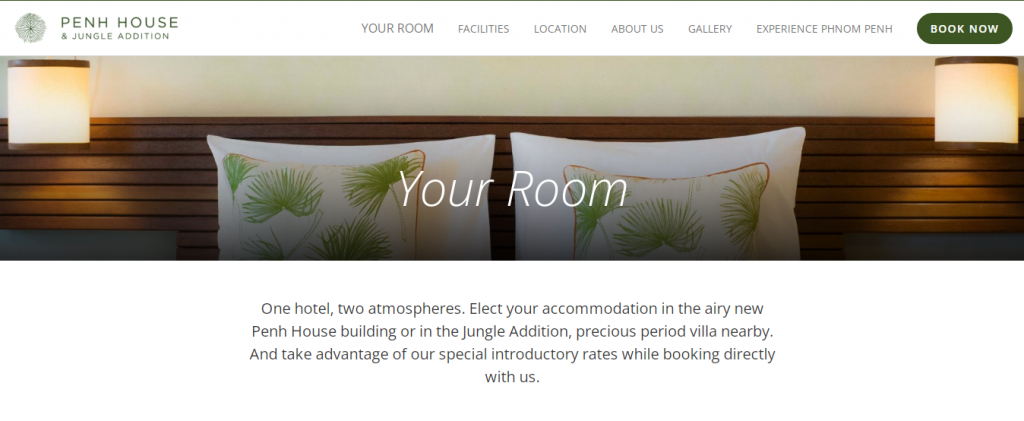
The third tactic is to get personal. Personal, here, simply means using the words “you” and “your” in your hotel copy.
Take a look at the hotel copywriting example above.
While other hotels either make it about themselves (“our rooms”) or keep things neutral (“rooms”), Penh House and Jungle Addition invite you to choose “your room”. The seemingly small decision to use the second person pronoun “you” actually makes a big impact. It eliminates barriers. And it’s that perceived warmth that helps the hotel stand out in a sea of impersonal (read: reserved) alternatives.
Q: What kind of copy will appeal to my ideal guest?
To write resonant copy, you must be intimately familiar with your client base. Who are your guests? What do they value? What makes them tick? Without such insight, your hotel copywriting isn’t going to land the way you hoped it would.
Having said that, knowing your customer is just half of the equation; the other half involves know-how. We’re not just talking about skillful writing but deploying the right strategy to connect with your reader where and when it matters most.
The following hotel copywriting examples show you fail-proof tactics to appeal to your ideal guest.
Sunstar Hotel Arosa (Switzerland)
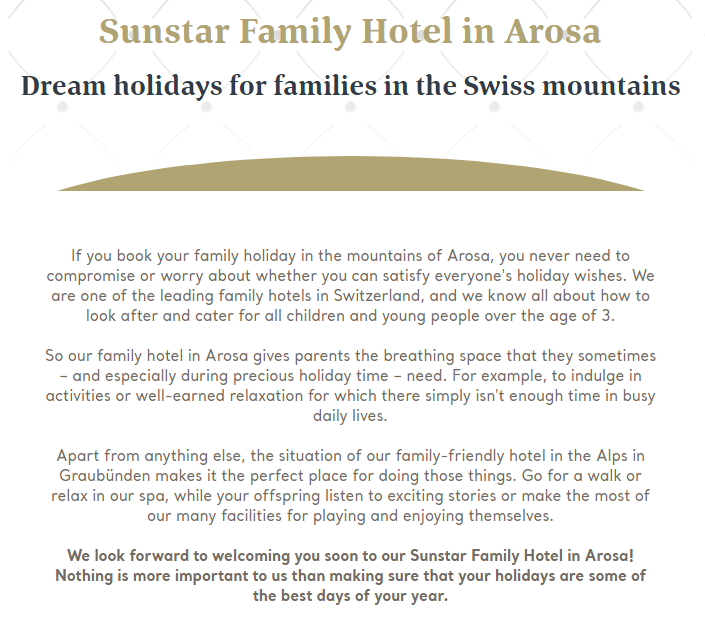
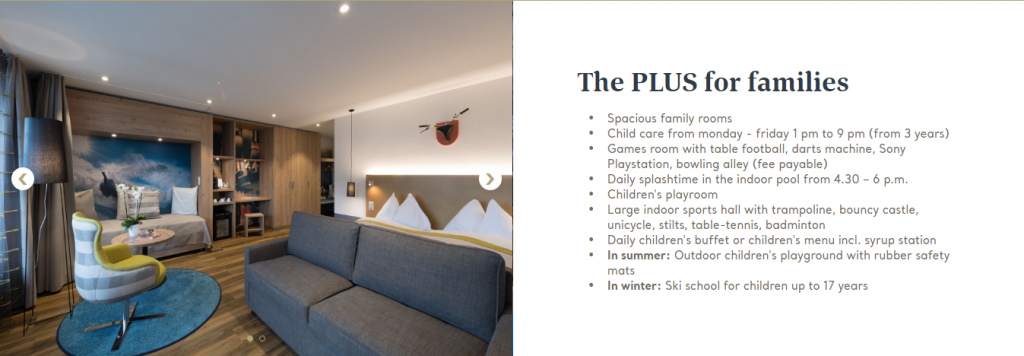
My first tip for you to engage your ideal guest is to highlight relevant value. Put another way, you need to convince readers you have what they want. Makes sense, right? So, if you’re a family hotel, you’ll focus on what matters most to families going on vacation because that’s how you’ll get parents to book with confidence.
Here’s how Sunstar Hotel Arosa does it:
- Inform the reader that they’re a leading family hotel in Switzerland.
- Reassure parents that they know how to care for (and entertain) kids aged 3 and above.
- Promise (well-deserved) breathing space for parents.
- Guarantee a safe and family-friendly environment in the Alps.
- Mention in-room amenities or hotel facilities that cater to children.
Maia Resort Quy Nhon (Vietnam)
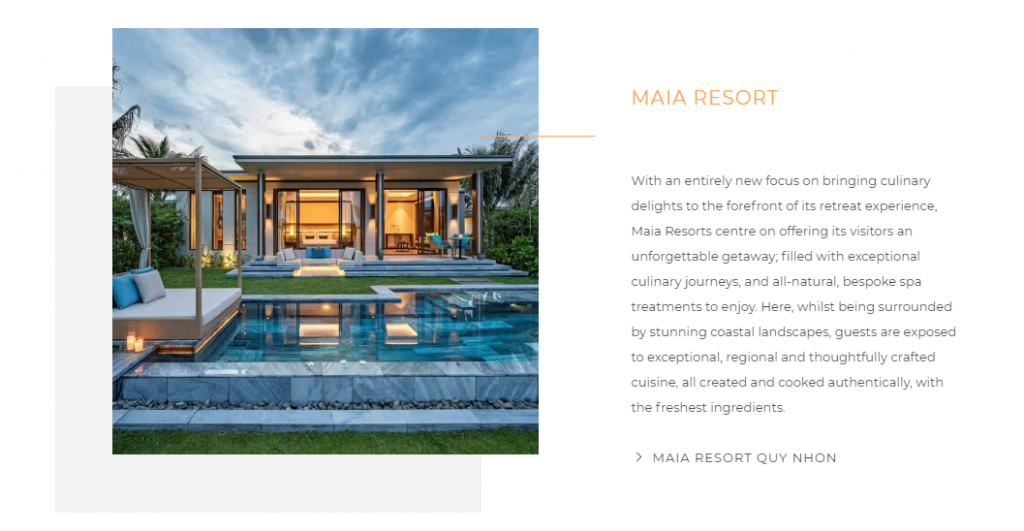
Another tactic is to tap into your target segment’s aspirations. The idea is to get readers to see themselves in what you’ve written—or have them wanting to be that version of themselves—to get them to take action.
So, who was your hotel envisioned for? What motivates them? What do they dream of? And, in the age of social media, how do these potential guests want the world to perceive them? These are the questions you need to answer to write effective hotel copy.
For reference, Fusion Hotel Group does an outstanding job at defining and then describing their ideal guest in their client-facing copy. Just take a look at the hotel copywriting example above to see what I mean.
If you value good food and place equal importance on wellness while on vacation in Vietnam, then there are no questions about it: Maia Resort Quy Nhon is where you want to be.
Moxy Amsterdam Houthavens (Netherlands)

A distinct brand voice works wonders, too. Very often, in fact, that’s what draws readers in.
Take a look at Moxy Amsterdam Houthaven (or any Moxy Hotel website for that matter). Their hotel copy isn’t drab and dreary because they let their brand’s personality shine through. And that’s not accidental—it’s 100% intentional.
Their brand voice is so important as it plays a crucial role in attracting a specific type of traveler: Young professionals seeking style and quality without a stuffy or uptight atmosphere.
Q: What’s the best way to keep readers on my website?
The most effective way to get readers to spend more time on your website is to be engaging. When you’re engaging, people naturally want to keep reading. On that note, take a look at how these hotels manage to keep their audiences glued to their screens.
Hotel Sultania (Istanbul)
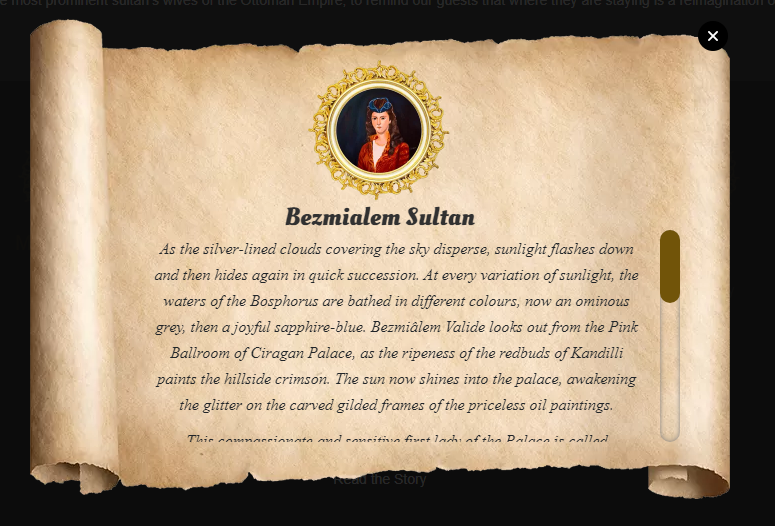
Have you tried sharing relevant stories? Unlike the earlier example of storytelling marketing, here it’s about creative writing whereby you share stories of interest with your web visitors.
Hotel Sultania, for example, features mini stories of prominent women: Ottoman princesses, consorts and the like from times past. These stories aren’t random; they tie in perfectly with the hotel’s location right in the middle of Old Town, “the part of the city that has witnessed all of [the city’s] phases through the course of history”.
Cape Heritage Hotel (South Africa)
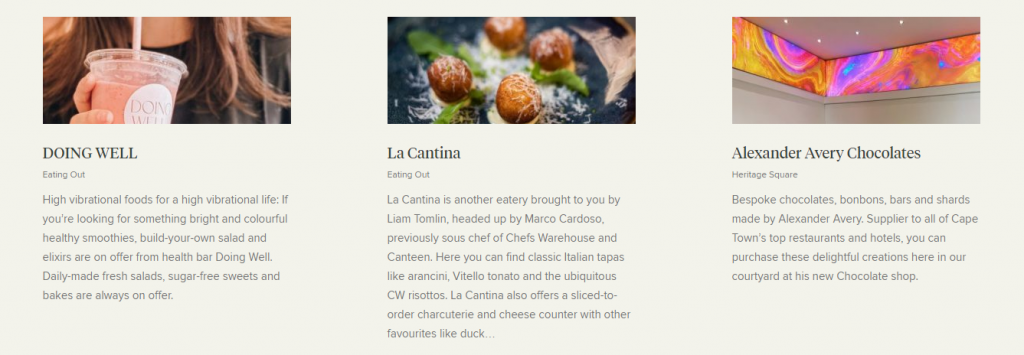
Cape Heritage Hotel in South Africa uses a different strategy. They have destination-related recommendations (four pages of it!) for their target audience’s perusal. Topics cover a wide range of interests from F&B hot spots to tourist attractions and events.
The takeaway is this: Be a source of useful information, so that readers willingly spend more time perusing your website. By the way, it’s almost important to balance evergreen and dynamic content, so that you don’t just rank for certain search terms—you’re also always current.
Awasi Iguazu (Argentina)
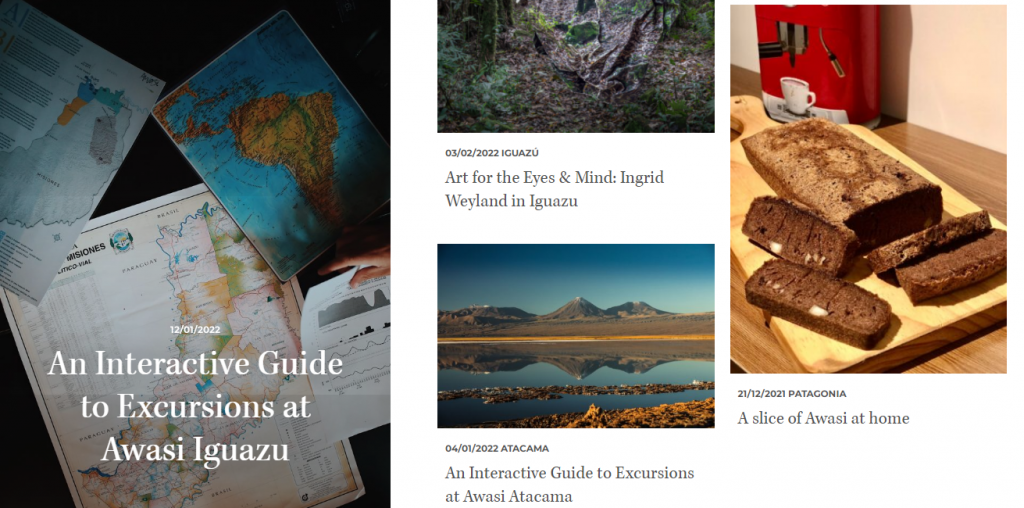
Let’s take a quick breather from copywriting to discuss the virtues of content writing.
Did you know that a hotel blog is the perfect home for carefully-curated content? Wanderlust-inspiring, heart-warming, or eye-opening articles that are on-brand and give prospective bookers valuable insight into your destination, property, and values. Plus, because your content also entertains, readers will come back for more!
Awasi Iguazu’s blog is the perfect example.
Q: How do I write an attractive hotel room description?
Travelers are tired of the same old, same old. That is to say, they’re uninspired by generic room descriptions that look like they’ve been copied and then pasted across hotel brands. They’re bland, they’re boring—but they don’t have to be.
Gibbs Farm (Tanzania)

Attractive room descriptions transport the reader to your property. In the same vein, the best room descriptions inspire dreams. That’s precisely what Gibbs Farm manages to do. It has you picturing yourself sitting out on your private veranda, taking in the tranquil African sunrise while sipping on a warm cup of freshly roasted coffee. Next thing you know, you’ve hit that “book a farm cottage” button!
Maremegmeg Beach Club (Philippines)

The best hotel room descriptions are grounded in facts (and figures)—room size, furnishings, in-room amenities—but they also trigger yearning. The create a longing that can only be satisfied by experiencing the place first-hand. And guess what? You don’t need to write much to achieve all that.
Case in point: Maremegmeg Beach Club and their ‘less is more’ approach.
Their descriptions prove that short equals impactful. Two lines revolving around the fiery Palawan sunset are more than enough to pack a punch—and motivate readers to book.
Mashpi Lodge (Ecuador)
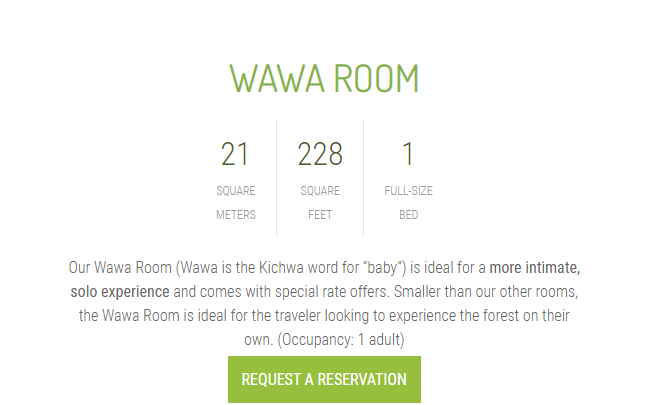
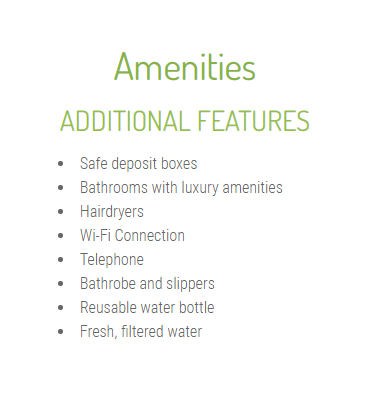
Last, but certainly not least, choose your words wisely. To clarify, you want to use vocabulary that resonates with a particular segment, whether solo traveler, couple, small family, or group of friends sharing accommodation.
For example: Mashpi Lodge says their Wawa room is ideal for a “more intimate, solo experience”. This implies warmth and turns the room into an inviting space that won’t feel empty, cold, or lonely.
Q: What should I focus on to generate interest in our F&B establishments?
Good question! The fact is, your “food scene” could be one of the deciding factors that converts a looker into a booker. At the same time, most travelers don’t want to spend every meal dining in-house. They want to experience the gastronomic landscape the way locals do. (And they want variety.) All this to say, you’ll need to be extra creative to attract diners. The following examples show you such F&B hotel copywriting at its finest!
Siam@Siam (Thailand)

One strategy is to focus on the menu. The idea here is to drum up excitement for local cuisine but also around your establishment’s unique spin on said cuisine. Are you offering a refined take on street foods? Going ultra high-end? Inviting diners for an Omakase experience? Whatever it is, your copy’s goal is to awaken both curiosity and interest.
Taan at Siam@Siam Bangkok does just that. They build anticipation by telling prospects what to expect: Local, sophisticated, and flavor-complex dishes. That’s followed by an intriguing statement: Thai food that’s not afraid to break the rules. In other words, this isn’t necessarily the Thai food you’re used to, which is what ultimately inspires people to check them out.
Mövenpick Hotel and Convention Centre KLIA (Malaysia)
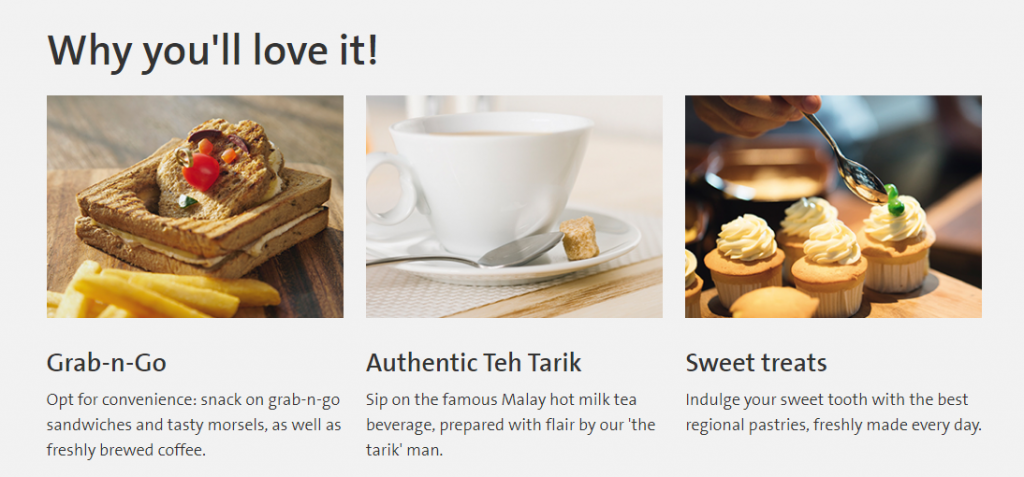
Another strategy is to put the spotlight on features that make your restaurant, cafe, bar, or lounge worth dropping by. That could be mouth-watering treats created by master chefs; the finest coffee creations prepared by award-winning baristas; exciting drink concoctions shaken and stirred by adventurous mixologists. Or your copy might focus on practical matters like convenience, e.g. grab and go meals for MICE participants or office workers in the area. Alternatively, you might draw attention to a gustatory experience that’s tied to your destination—an absolute must-try.
Amari Yangshuo Guilin (China)

Finally, have you tried emphasizing your restaurant’s theme? After all, we dine out to please all our senses—ambiance is just as important as food.
For example: Amaya Food Gallery at Amari Yangshuo Guilin leans in on its indoor hawker stall concept with live cooking stations. S,o if a traveler has always wanted to experience Asian street food (without the street part of it), then this restaurant gives them just that. They can watch chefs in action and enjoy both Asian as well as international favorites in a clean and vibrant venue!
Q: How do I properly address COVID-19 in my hotel copy?
We can’t have a Q&A that doesn’t tackle the elephant in the room: COVID-19 and its impact on operations.
Some hotels choose to gloss over this topic for various reasons:
- Guests ought to know that any decent hotel will already have hygiene measures in place. There’s no need to expound on what those may be.
- No one wants to be reminded of the pandemic (or COVID-19) while planning a trip. Good vibes only!
While that might be the case for some travelers, for others transparency is key to earning their trust—and their business.
So, what’s a good way to write about COVID-19 and the changes its existence has on your hotel? Here are some laudable examples.
Bravo Siargao (Philippines)
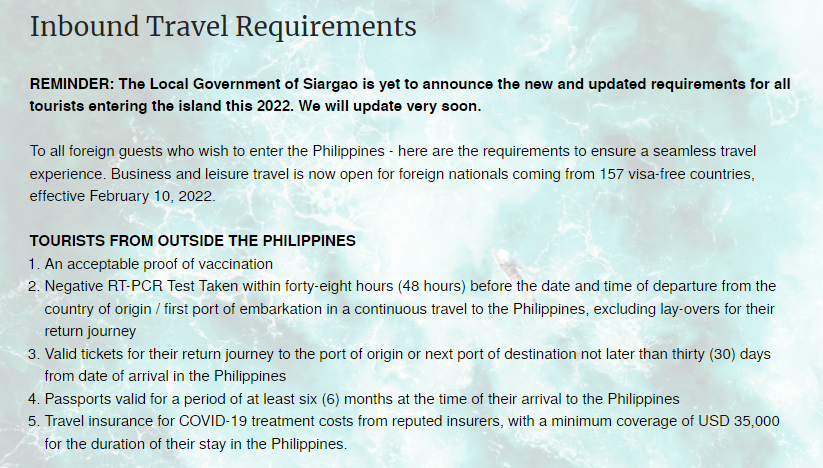
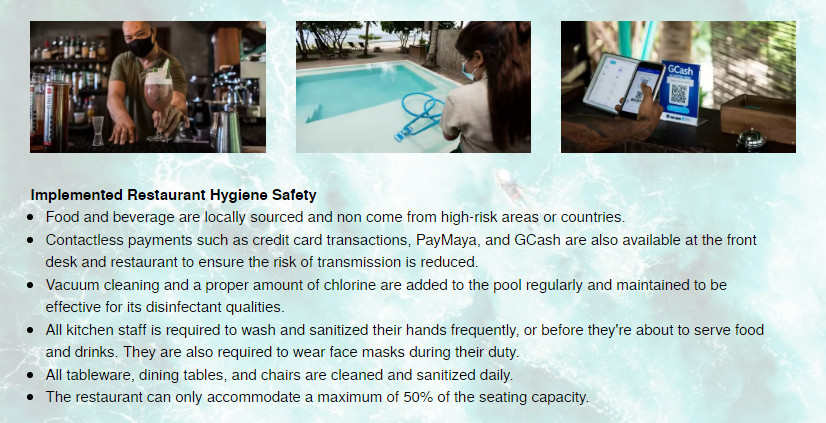
These folks are first on this list of hotel copywriting examples because they cover both the macro and micro of COVID-19 as it relates to their guests.
First, they have a page dedicated to inbound requirements for both domestic and international travelers. It includes everything a tourist ought to know about travel to Siargao at a given point in time. Second, they list out all the hotel-wide measures they’re taking to keep guests safe.
Take note of tone and presentation: It’s bulleted, to-the-point, and business-like. These are important matters that must be clear and easily understood, hence, it’s not the place to be verbose, use fancy language, or showcase creativity.
Vico Milano (Italy)
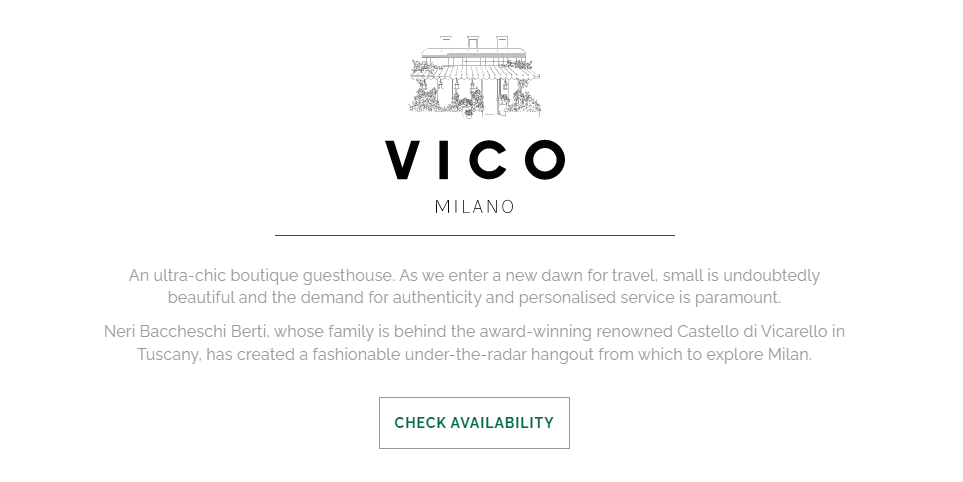
Addressing COVID-19 doesn’t always have to be overt or use an in-your-face style of writing. Here, VICO Milano briefly touches on “a new dawn for travel” on its homepage—that’s it. And unless you’ve been living under a rock, you already know what that’s all about.
They also place subtle emphasis on the small being beautiful and how a personalized service makes all the difference. With just one sentence, these guys remind us that fewer people, no crowding, and less interaction with strangers sure beat potential super spreader spaces. Even better, it even ties in with the growing preference for authentic travel.
Hotel With Urban Deli (Sweden)
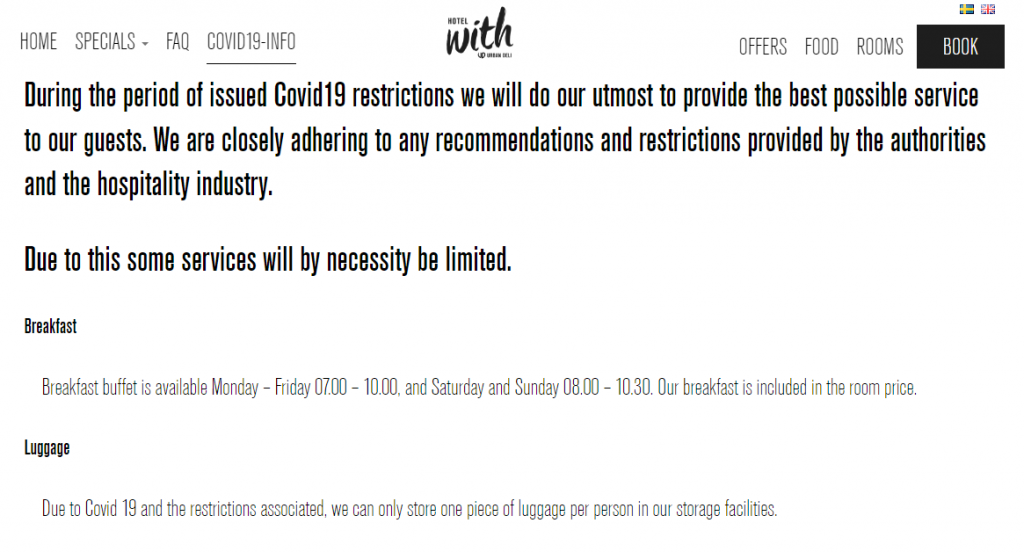
Last but not least, it’s one thing to talk about all the safety measures you’ve put in place and another entirely to mention what might cause inconvenience to your guests.
Others may refrain from writing about things that might deter potential clients from actually pushing through with a booking but these guys at Hotel With Urban Deli know it’s a lot worse to disappoint guests once they’re already on site. Those annoyances translate into negative reviews or bad word of mouth, which is a heck of a lot harder to fix than simply giving prospects a heads up of what to expect when they get there.
As with Bravo Siargao, note how simple their COVID-19-related copy is. There’s no beating around the bush and no excuses—just important information.
Speaking of COVID-19, this post shows you how to write different kinds of COVID-19 safety announcements for your guests.
And that brings this post on hotel copywriting examples to a close! A lot to take in, right? Truth be told, even with examples in front of you, writing conversion-boosting hotel copy isn’t easy. But you don’t have to go it alone! If that’s what you’re struggling with right now, or if you’d appreciate a second pair of eyes to audit what you’ve written, just get in touch.